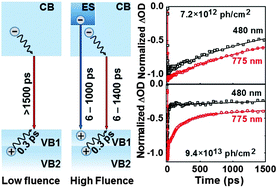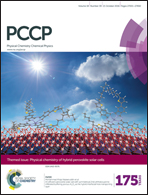How photon pump fluence changes the charge carrier relaxation mechanism in an organic–inorganic hybrid lead triiodide perovskite†
Abstract
This study explores the excitation wavelength and fluence dependence of processes occurring in formamidinium lead triiodide (FAPbI3) film using time-resolved transient absorption and terahertz spectroscopies. The results indicate that second-order processes are responsible for charge carrier recombination at low fluences of the absorbed photons (below 8.4 × 1012 ph per cm2). An increase in fluence leads to the appearance and successive reduction of the time component assigned to the Auger recombination of free charge carriers (240–120 ps). Simultaneously, the bimolecular recombination time decreases from ∼1400 to ∼700 ps. Further increasing the pump fluence produces an exciton population that recombines in 6 ps. The comparison of two characteristic bleaching bands located at 480 and 775 nm provides evidence for the validity of the two valence bands model. Excitation with higher fluences results in a marked difference in the probed dynamics at these bands, reflecting the action of two excited states at the conduction band. Our results demonstrate that a single model cannot be applied in characterizing the perovskite absorber transitions at all pump fluences. These findings are relevant in understanding their operating mechanism under specific experimental conditions, which should differ for perovskite based solar cells, lasing media or photon detectors.

- This article is part of the themed collection: Physical chemistry of hybrid perovskite solar cells

 Please wait while we load your content...
Please wait while we load your content...